The Brazos Review: AMD's E-350 Supplants ION for mini-ITX
by Anand Lal Shimpi on January 27, 2011 6:08 PM ESTHeavy Lifting: Performance in Complex Workloads
Brazos is clearly faster than Atom in light workloads, but what about in more complex/heavier applications? Are the Bobcat cores enough to allow E-350 systems to move up in the world or will they still be confined to the web browsing/email usage models of netbooks? I've run the E-350 through our entire Bench suite to find out. If you want the full gamut of results head over to CPU Bench, but I've chosen a few here. I also included performance results from a 2.66GHz Pentium 4 to put things in perspective for users of really old systems.
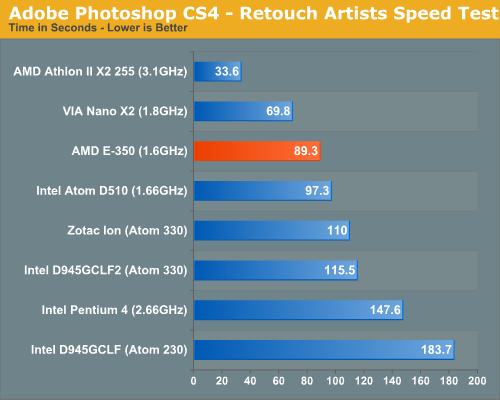
Photoshop CS4 performance is not half bad on the E-350 compared to other similarly priced platforms. Also impressive is the E-350's performance advantage over the old Pentium 4. Compared to the Athlon II X2 however the E-350 is still noticeably slower.
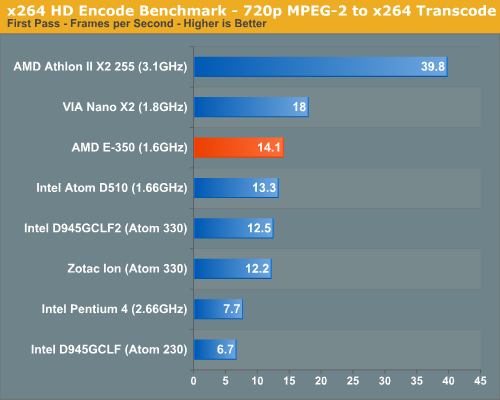
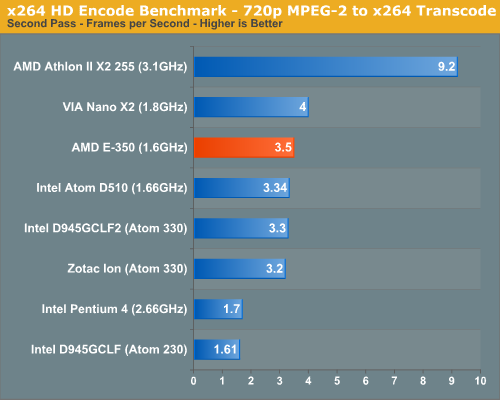
The standings and performance trends continue in our x264 encode benchmark. I don't expect you to do a lot of video transcoding on the E-350 as it's not much faster than Atom here. VIA's dual-core Nano is a bit quicker but still not enough to make this a viable usage case.
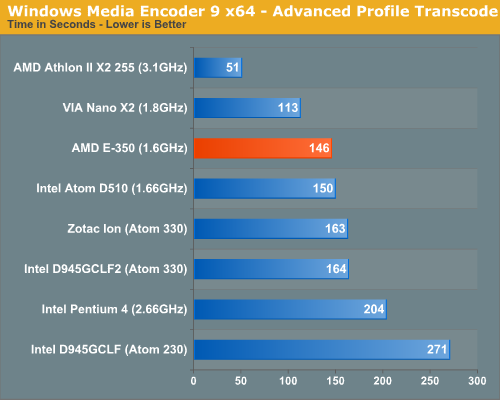
Windows Media Encoder provides a far lighter workload, but the standings don't change. The E-350 is faster than anything Atom based, faster than the old Pentium 4, but slower than VIA's Nano X2.
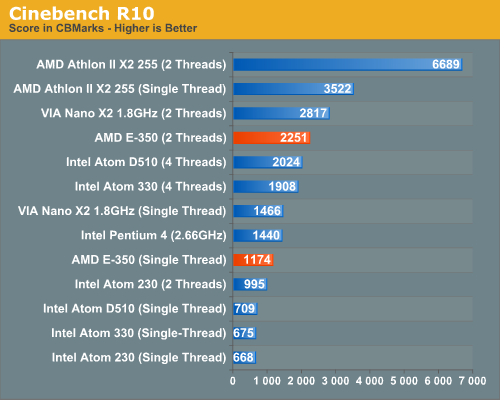
While I don't expect E-350 users to do any offline 3D rendering work, Cinebench does give us a good characterization of single threaded performance. The problem with Atom is that its single threaded performance isn't nearly as good as its multithreaded performance. In all of the previous benchmarks an Atom D510 is clearly quicker than the old 2.66GHz Pentium 4, but looking at single threaded Cinebench R10 you get a different story entirely. The P4 has nearly twice the single threaded performance of an Atom D510.
The E-350 is still a bit behind the Pentium 4 in single threaded performance, but it's not nearly as bad as Atom. The out-of-order execution engine helps tremendously here. What you get as a result is a system that doesn't really feel slower than a 5 year old PC but has the features of a more modern system.
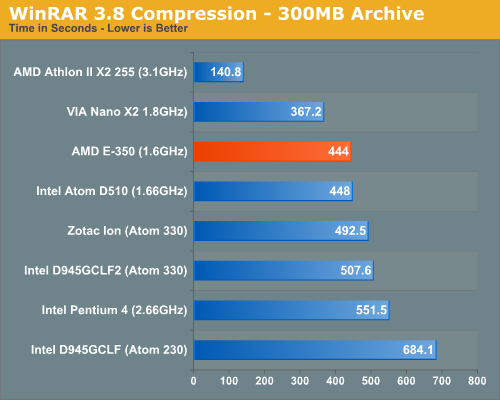
Overall the E-350 is clearly faster than Atom ever was at running these heavier workloads. The highly threaded workloads aren't much faster on E-350 vs. Atom thanks to the latter's Hyper Threading , but single threaded performance continues to play an important role and is a huge advantage of AMD's. VIA's simple out-of-order architecture is consistently faster than the E-350, however I don't expect to see widespread adoption or support for VIA's platform (at least compared to AMD's). Compared to the larger out-of-order x86 cores the E-350 is still in a lower performance class, the Athlon II X2 is easily twice as fast as the E-350 in these tests.
Ultimately the same rules that applied to Atom based systems apply to Brazos systems:
1) Swapping to disk is painful so you need enough memory (I'd recommend no less than 2GB for Windows 7, ideally 4GB) and you'll want a fast HDD. My preference is still an SSD, even a low end value drive over even a fast hard drive. Even a low end SSD (e.g. Kingston SSDNow V100) will make a Brazos system feel acceptably fast.
2) Outside of media playback and some gaming, you're still limited in the types of applications and workloads you can run on Brazos. The Brazos platform is great for web browsing/email workloads, but don't try to do too much more with it. The advantage over Atom here is that Brazos just does those things noticeably faster.










176 Comments
View All Comments
ocre - Friday, January 28, 2011 - link
hahaha, You need to educate yourself a little more on the advantages/disadvantages of both the x86 and ARM architectures before you go around posting ignorant statements like these. If we assumed your statement: is true: "E-350 has roughly 5 times the performance of Tegra 2" it would still be nothing to brag on becaue the same tegra 2 uses 7-9 times less energy than the E-350. This makes a mere 5 time performance a joke.But on top of that, there is no good reasonable way to conclude where these architectures rate towards one another. The software is radically different. There is not enough to go on for any useful conclusion and what little we do have is subject to a very special cases where there is SW that in the end results to similar obtained data. But the entire process is different and while we know the x86 is pretty well optimized, any ARM based counter SW is in its beginnings. X86 has the luxury of optimizations, ARM will only get better when SW engineers find better ways to utilize the system. But this is considering an actual case where there is SW similar enough to even reasonably attempt to measure x86 vs ARM performance. For the most part there the SW of each architecture is so radically different. ARM is extremely good at some things and not so good at others and this doesnt mean it cant be good, in some cases the SW just hasnt matured yet. All this matters little cause at the end of the day, everyone can see that the exact opposite from your statement; The superiority of ARM is just unmatched by x86 when it comes to performance per watt. This is undisputed and x86 has a long long way to go to catch up with arm (and many think it never will). Alls Arm has to do is actually build 18w CPUs, they will be 3 to 4 times more powerful than the e-350 based on the current ARM architecture.
jollyjugg - Friday, January 28, 2011 - link
Well your last statement is simply laughable. Because all we have from ARM right now is chips which run in smartphones and tablets. ARM based processors are not exactly known for their performance as much as their power. While it is true that performance/watt is great in ARM today, it also true as any modern microprocessor designer would say that, as you go up the performance chain (by throwing more hardware and getting more giga Hz and other tweaks like wider issue and out of order etc), the mileage you get out of the machine improves so does the drop in performance/watt. There are no free lunches here. I doubt a good performance ARM architecture will be a whole lot different that an x86 architecure. While the lower power is an achilles heal for x86 as is the performance an achilles heal for ARM. You mentioned software maturity. It is laughable to even mention this in this cut throat industry. Intel showed its superiority over AMD by tweaking the free x86 compiler it gave away to developers to suit its x86 architecture compared to its rival and the users got cheated until European commision exposed Intel. So dont even talk about software maturity. The incumbant always has the advantage. ARM first has to kill Intel's OEM muscle and marketing muscle before it can start dominating. Even if it did the former two, there is something it can never do, which is matching intel's manufacturing muscle. Intel by far is way better than even the largest contract manufacturer TSMC whose only task is to manufacture.Shadowmaster625 - Monday, January 31, 2011 - link
Nonsense. ARM is more optimized that x86. x86 code is always sloppy, because it has always been designed without having to deal with RAM, ROM, and clock constraints. When you code for an ARM device, you are presented with limits that most software engineers never even faced when writing x86 code. When writing software for Windows, 99.9% of developers will tell you they never even think about the amount of RAM they are using. For ARM it was probably 80% 10 years ago. Today it is probably less than 20% of ARM software engineers who would tell you they run into RAM and ROM limitations. With all this smartphone development going on today, ARM devices are getting more sloppy, but still nowhere near as bad as x86.Shadowmaster625 - Monday, January 31, 2011 - link
Best buy is still littered with them. Literally. Littered.e36Jeff - Thursday, January 27, 2011 - link
what review were you reading? The only bug that is actually mentioned is the issue with flash, which AMD and Adobe are both aware of and should be fixed in the next iteration of flash. Stop seeing anything from AMD as bad and Intel as good. For where AMD wants this product to compete, this is a fantastic product that Intel has very little to compete with now that they locked out Nvidia from another Ion platform.codedivine - Thursday, January 27, 2011 - link
Ok one last question. Is it possible to run your VS2008 benchmark on it? Will be appreciated, thanks.Anand Lal Shimpi - Thursday, January 27, 2011 - link
Running it now, will update with the results :)Take care,
Anand
Malih - Sunday, January 30, 2011 - link
I'm with you on this.I'm thinking about buying a netbook and may be a couple net tops with E-350, which will mostly be used to code websites, may be some other dev that require IDE (Eclipse, Visual Studio and so on).
micksh - Thursday, January 27, 2011 - link
how can it be that "1080i60 works just fine" when it failed all deinterlacing tests?Anand Lal Shimpi - Thursday, January 27, 2011 - link
It failed the quality tests but it can physically decode the video at full frame rate :)Take care,
Anand